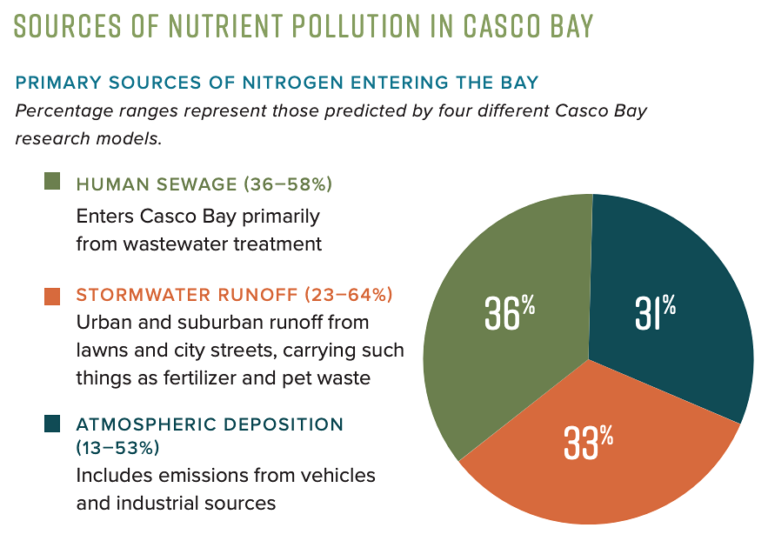STUDY
CONTAMINATION IN CASCO BAY
Reducing the impacts of current and legacy pollution sources is critical for the economy as well as for the health of the estuary and its many communities.
Even though Casco Bay is still relatively healthy compared to many similar bays on the East Coast, nutrient pollution, principally caused by nitrogen, is an emerging problem. The Bay is experiencing preliminary ecological effects of excess nutrients, including algae blooms, damage to eelgrass beds, and coastal acidification. Population growth and climate change effects like warming waters and altered precipitation are likely to make the problem more severe in future.
Toxic pollution is also present in the Bay, its sediments, and in the tissues of its living organisms, including clams, fish, birds and marine mammals. Toxics like heavy metals and organic contaminants can pose a threat to the health of aquatic life and humans.
Historic industries around Casco Bay — including shipyards, tanneries and textile factories — have left a legacy of toxic chemicals in the Bay’s sediment and waters. Today, nonpoint source pollution in the form of contaminated stormwater is the major contributor of toxic chemicals to the Bay. Pollutants are also deposited from the air via local and distance sources, in the form of rain or dust.

CURRENT PROJECTS
Tackling Nutrient Pollution. Nutrient pollution in Casco Bay has been formally recognized by the Legislature as a statewide priority. Casco Bay Estuary Partnership and many partners have been taking action to better understand, convey and reduce the negative impacts of nutrients on Casco Bay.
CBEP and partners are monitoring nutrients around Casco Bay to provide real-time data on nutrient processes. CBEP’s “NuLAB”, a land-based nutrient analyzer, was deployed off the Portland Street Pier in South Portland, and automatically collected nitrate, nitrite and ammonium samples every two hours for two summers. Seeing a likely connection between nitrate/nitrite concentration and rainfall events, CBEP may redeploy the sensor earlier in spring to capture data during heavy rainfall events. All data collected so far is preliminary.
You can see historical buoy data collected by University of Maine’s SEANET (a research network focused on Sustainable Ecological Aquaculture) buoy network here.
Download a report of the Casco Bay Nutrient Council, Nutrient Pollution in Casco Bay, Maine, here.
Download CBEP’s fact sheet, “Nutrient Pollution in Casco Bay,” here.
Next Steps. CBEP and Maine Department of Environmental Protection are jointly convening a Portland Area Nitrogen Criteria Advisory Group that brings together representatives of municipalities, wastewater treatment plant operators, stormwater professionals, environmental groups, government agencies and academic institutions. The Advisory Group will gather information, share perspectives, and provide advice to DEP on how to move forward with establishing nitrogen standards.
For More Information
Contact Curtis Bohlen, CBEP Director, Curtis.Bohlen@maine.edu, (207)780-4306.